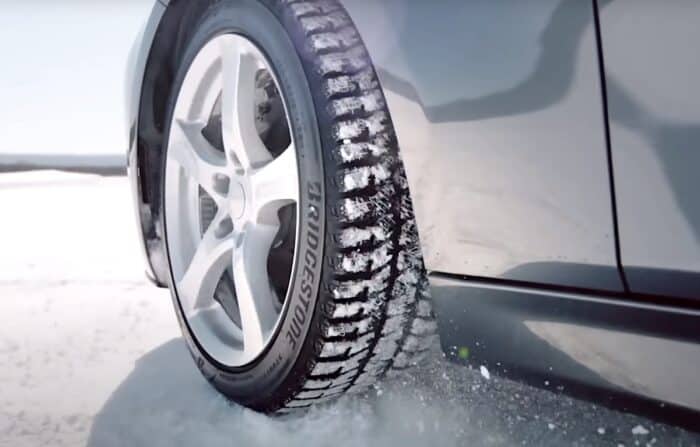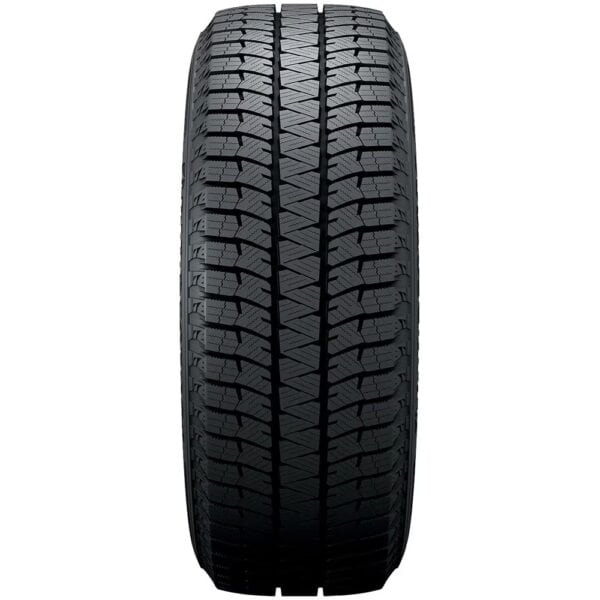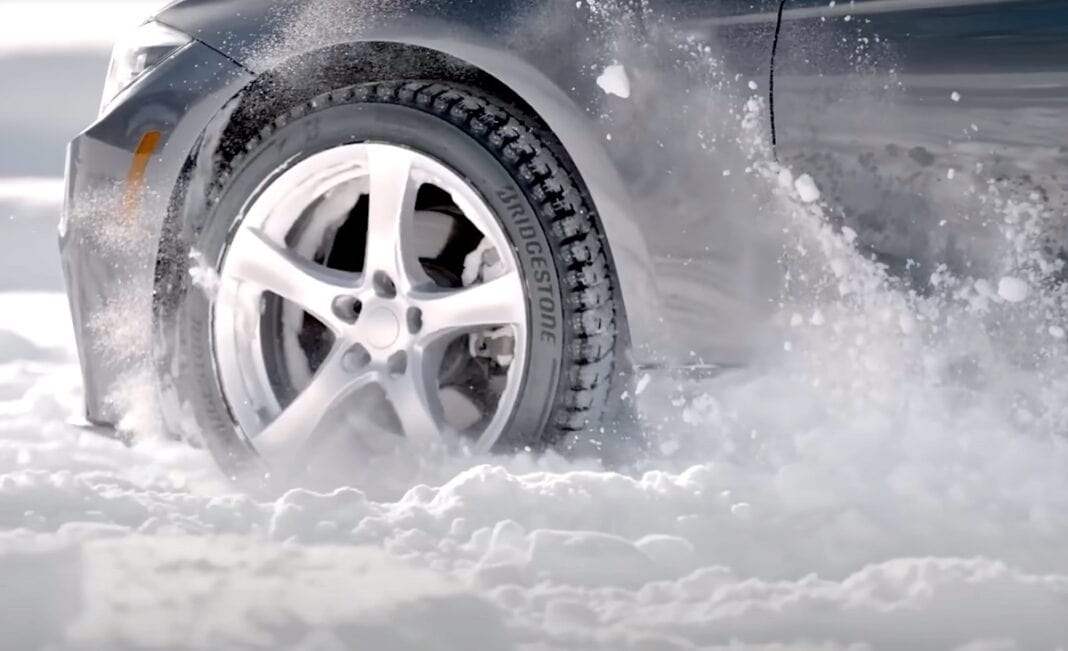When the Blizzak line of winter tires launched in 1988, Bridgestone intended them as an alternative to conventional studded tires for the Japanese market. In the numerous updates and iterations that followed over the next 25 years, the Blizzak winter tire range grew to include more options, technologies, and performance-enhancing attributes to drive further value for shoppers around the globe.
Today, the Blizzak brand is well known for helping drivers successfully tackle winter driving conditions. The name ‘Blizzak’ has earned a place on the mental radar of winter tire shoppers, helping make them one of the most popular winter tire lines in 2023 for both conventional and electric vehicles.

Quick Specs:
- Tire Type: Winter
- Available Rim Sizes: 14, 15, 16, 17, 18 inches
- Speed Rating: H (up to 130 mph) or V (up to 149 mph)
- Load Index: 82 to 105
- Tread Depth: 12/32 inches
- Tread Design: Directional
- Tread Material: NanoPro-Tech Multicell Compound
- Warranty: Limited treadwear warranty
The brand clout is unmistakable: tell your friends and family you’ve just installed a set of Blizzaks, and they’ll know you mean winter tires straight away. That’s the sort of brand recognition that marketing departments strive for.
A recent 1,340-mile or 2,200-kilometer test of the Blizzak WS90 winter tires in Northern Ontario, Canada, helped reveal what’s behind the popularity of these well-known winters. Though a few minor complaints presented themselves, the ability of these tires to turn virtually any car or crossover into a superhero on winter roads has helped move a lot of units to customers, building brand loyalty along the way.
So, how does the Bridgestone Blizzak WS90 drive?

Testing conditions covered the gamut of temperatures and road surface conditions characteristic of a Northern Ontario winter, with plenty of use on hard-packed backroads surfaces, frigid bare pavement, deep powder, and slushy ice. Our test vehicle was the all-new-for-2023 Honda HR-V, a compact crossover model with All-Wheel Drive (AWD).
A revised, silica-enhanced tread compound is selected for the latest iteration of these tires. Expert at maintaining grip and flexibility, even in extreme cold, the new compound lays the foundation for additional tweaks that optimize the construction and tread pattern of the tires for further improved grip, stability, wear properties, and noise levels.
Blizzaks noise on the roads
Those noise levels were among the first things we noticed during our test– which started with a 6-hour highway drive in a snowstorm. Whether snow-covered or bare, the sound of the Blizzak WS90 tires rolling down the highway was more subdued than we expected for a satisfying delivery of quiet grip.
Though not all shoppers value low noise levels from their winter tires equally, the performance of the Blizzak WS90 in this regard makes for a quieter drive that’s easy to appreciate, especially in luxury applications.
According to experts, retailers, and owner reviews, a key draw to the Blizzak WS90 tires is their strong and consistent performance across various winter driving situations.
Braking duties on the snow and ice

This is perhaps most apparent during panic braking exercises, where the WS90s tend to deliver some of their most noteworthy performance.
Specifically, drivers can expect consistent and reliable reactions from a Blizzak-equipped ride when it’s time to stop in a hurry.
When stopping quickly on a polished, hard-packed surface, our initial impression was highly positive. We were surprised at how much grip the WS90s generated with the brake pedal applied aggressively, as well as a hearty shove out of our seats and against the seatbelts before the test vehicle’s anti-lock braking system engaged. That’s par for the course with a quality set of winter tires, but the Blizzak-equipped HR-V gave us some of the most impressive pre-antilock stopping power we’ve recently noted in winter tire testing this year.
As with braking, drivers can expect smooth and consistent traction and a drive that nicely isolates them from the more unsettling sensations familiar when tackling slippery surfaces.
Put another way, it’s possible to dive remarkably deep into the brake pedal before the antilock system engages. In a few inches of powder and especially on hard-packed snow, this translates into a feeling more aligned with driving on clean, warm pavement. Here, our Honda’s advanced braking and traction management systems picked up on the extra grip from the tires, helping to deliver stable and straight stops.
On icy or slush-covered surfaces, our test vehicle felt a little squirmier and less precise beneath us in the same hard-stopping exercises. However, the crossover remained easy to control and responded to additional steering inputs and adjustments without surprises.
Corning and handling with the Bridgestone Blizzak WS90
During cornering situations on snow and ice, the WS90s tend to give up traction gradually, making it easier for the driver to predict the response from the vehicle and to handle the situation with less surprise and more confidence.
Even during spirited driving on slippery surfaces, there is a soft transition between slip and grip. This makes it easier for more novice drivers to feel well backed up by their tires and for more experienced drivers to adjust their inputs on the fly as required.
Owners tend to rate the Blizzak WS90 most favourably regarding ride comfort, snow handling, and wet handling– with dry pavement performance tailing slightly.
Complaints and Cons: noise levels and tread life
On complaints, most owner scores reflect a wish for lower noise levels, although our experience did not reflect this. Keep in mind that the noise levels you experience from winter tires will depend in part on the vehicle they’re installed on and how well it’s been maintained.
Additionally, some owners have scored the Blizzak ws90 tires the lowest for tread life, a common occurrence for winter tires in general. As with noise levels, the lifespan of your winter tires will depend on various factors relating to your vehicle, how you care for it, and how you drive it. Many owners report happily accepting increased treadwear levels in exchange for the performance delivered.
Related: 4 Simple Ways to Increase Your Winter Tire Lifespan
Smooth and consistent traction
Though the tread pattern generates more noise than expected when clearing thick slush at highway speeds, we noted above-average stability and confidence in this situation. Specifically, the WS90 rubber saw our compact crossover tester stay virtually straight and true even when encountering heavy slush deposits on the highway, with almost no tugging or pulling back at the steering wheel in the driver’s hands. As with braking, drivers can expect smooth and consistent traction and a drive that nicely isolates them from the more unsettling sensations familiar when tackling slippery surfaces.
We also found the performance of the Blizzak WS90 tires to be particularly refreshing when encountering standing water at highway speeds after a melt. Provided you’re traveling at a reasonable rate, the tread pattern chomps into puddles and quickly evacuates water for big splashes but has nearly no tendency to hydroplane.
Taken as a whole, we found our test tires to remain remarkably composed and unbothered in situations that can often result in some unsettling behavior from the vehicle.
Takeaway
All said, on a set of Blizzak WS90 winter tires, drivers can expect solid all-around performance across a plethora of typical winter driving scenarios, with solid performance under braking and while tackling slush and standing water at speed. Shoppers after a winter tire that leaves them feeling well backed up in all winter driving situations should find the Blizzak WS90’s a solid return on their investment.
When shopping for a set of winter tires, your options are numerous and daunting. In 2023, winter tires cover a wide range of prices, features, performance levels, and speciality options. As more Canadians than ever seek out SUVs and electrified vehicles, the market landscape is shifting with more specialty and targeted tire products offered to cater to their changing needs and tastes.


